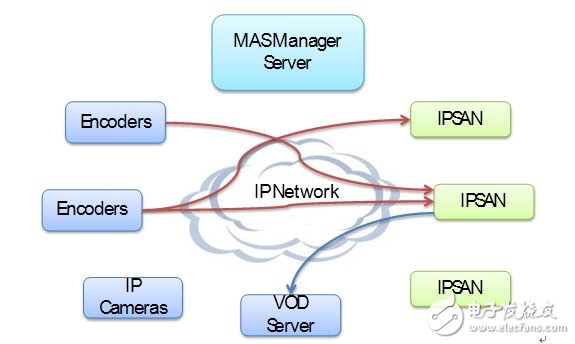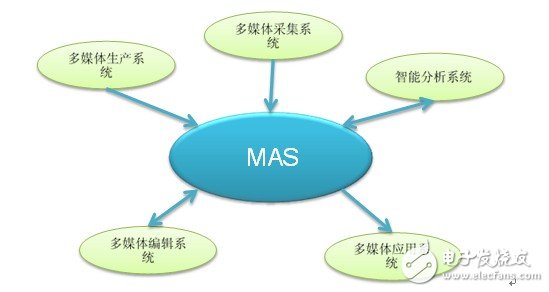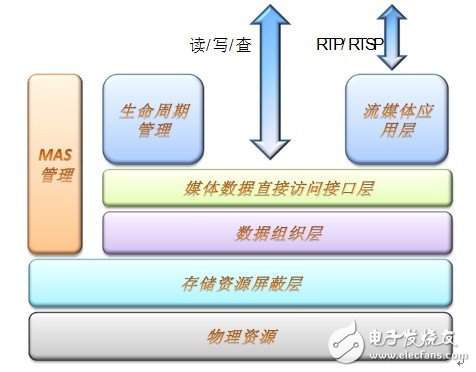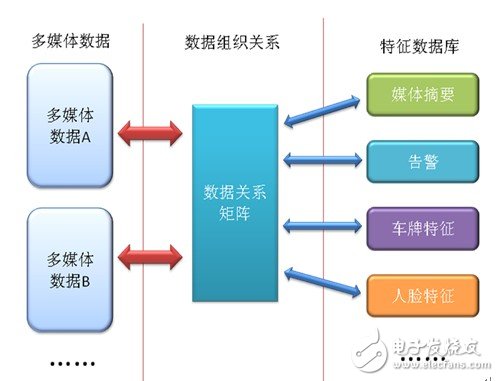The scope of multimedia storage is very wide, including various storage fields involving graphics and image applications, including website media, VOD applications, and medical PACS. Among them, video surveillance storage is an important form of multimedia storage. This article focuses on the multimedia storage in the surveillance field. The surveillance storage mentioned in the article refers to the multimedia storage in the surveillance field. In recent years, the animation production industry has proliferated in China. How to make data safe, large-capacity storage, flexible and convenient to use, and simple to maintain has been troubled by animation workers. Comply with the development of animation storage trends, promote enterprise animation storage security planning, and allow workers to create with more peace of mind?
In the face of massive amounts of data, it is obvious that people relying on humans to retrieve and mine multimedia data is obviously inadequate-low efficiency and high cost. With the gradual development and maturity of intelligent video technology, the need for intelligence has also begun to appear in the video surveillance system. However, most of the current intelligent systems and multimedia monitoring systems are two independent systems, and the data is not integrated. Become an obstacle to data sharing and efficiency improvement. The integration of multimedia video production systems and intelligent video technologies also puts forward high requirements on the storage systems of video surveillance, requiring effective integration of audio and video information produced by intelligent information and video surveillance systems. In this case, MAS came into being.
Multi-Agent System (MAS, Multi-Agent System) is a collection of multiple agents. Its goal is to build a large and complex system into a small system that communicates and coordinates with each other and is easy to manage. MAS is an important branch of distributed artificial intelligence (DAI, Distributed ArTIficial Intelligence), and is the frontier subject of artificial intelligence in the world from the end of the 20th century to the beginning of the 21st century. The purpose of the research is to solve large-scale and complex real-world problems, and solving such problems is beyond the ability of a single agent. Its research involves the knowledge, goals, skills, planning of the agent, and how to make the agent take coordinated actions to solve problems. Researchers mainly study the interactive communication, coordination and cooperation between agents, conflict resolution, etc., emphasizing the close group cooperation between multiple agents, rather than the autonomy and exertion of individual capabilities, and mainly explain how to analyze, design, and integrate multiple agents. Each agent constitutes a system that cooperates with each other.
1. MAS design ideasThe basic design starting point of MAS is "Professional Multimedia Storage System for Video Surveillance". It is based on H3C's mature application of block storage technology in the surveillance field, and innovates the original block storage technology to absorb space sharing in the file system. Features such as dynamic adjustment. Absorb the advantages of file system and block storage, and avoid their disadvantages, and implement a variety of reliability assurance designs for targeted video surveillance applications.
When the multi-agent system expresses the actual system, the structure, function and behavior characteristics of the system are expressed through the communication, cooperation, mutual solution, coordination, scheduling, management and control among the agents. The multi-agent system has autonomy, distribution, coordination, self-organization ability, learning ability and reasoning ability. The use of multi-agent systems to solve practical application problems has strong robustness and reliability, and has high problem solving efficiency. Multi-agent system is a qualitative leap in the application and research of agent technology. Through in-depth research on it by experts and scholars in different industries, we know that multi-agent systems have many advantages when used to solve practical problems.
1. Global access to storage resources-IP reachable means storage reachableMAS has local and networked access methods for storage resources, and provides a unified access interface for producers and users of storage resources. Producers and users do not need to know the location of storage resources. Storage resources in the network can be accessed globally. All storage resources are taken over by MAS and provide global storage services. This normalized access method can reduce the workload of subsequent application development.
For the common DVR/DVS and other methods in small networking, MAS can be installed in the DVR/DVS to provide local storage services.
The scattered data in a large-scale network is difficult to manage, and there are risks of information security, which will inevitably bring about the requirement of data concentration. Networked access to storage space is an inevitable way. The iSCSI protocol used by MAS is based on TCP/IP. The current popularity and maturity of IP networks provide a basic guarantee for the deployment of MAS. Through the iSCSI protocol, both the producer of media data and the visitor of media data (such as VODServer, third-party systems) can write or obtain data conveniently and quickly, and it can truly achieve IP reachability and storage reachability.

Figure 1 MAS network access model
2. Multi-reliability design-"Stability is overriding everything"The design goal of MAS is to provide 7×24 hours of service, so stability and robustness are the key indicators. MAS uses multiple methods at multiple levels to improve the stability and robustness of the system:
The bottom layer uses Raid redundancy technology
The bottom layer uses Raid5 technology to ensure redundant protection of storage space. When a single disk is damaged, the Raid5 technology can be used to recover the data to avoid damage to the metadata and multimedia data of the MAS.
Separate operation of data area and metadata area
In the face of the massive data generated by video surveillance cameras, ordinary desktop-level file systems will face great problems both in terms of stability and performance. Frequent, different paths and a large number of concurrent file system metadata areas will be accessed. Unbearable. The MAS system strictly controls the access of multimedia data and metadata. Metadata can only be operated by the manager of MAS-MASManagerServer. Producers and users of multimedia data are strictly prohibited from operating metadata. The separation of the operation of the multimedia data and the metadata area can ensure that if the MASManager Server fails or goes down, the normal access of the multimedia data will not be affected. The producer of the media data can continue to store the data, and the visitor of the media data can continue Read the data.
Redundant protection of metadata area
MAS also has a redundant design for the metadata area. When an unexpected exception occurs, the system can find the correct metadata based on the redundant information in the MAS metadata area. For example, if MASManagerServer is powered off due to some reason, its operations on the metadata area may only be partially completed. At this time, there is an error in the data in the metadata area, and MASManager Server will automatically find out based on the redundant information after it is powered on again. The correct state ensures the normal operation of the MAS system.
3. Shared block storage - maximize strengths and avoid weaknessesMAS has expanded the design of H3C's original block storage technology, so that one MAS volume can be used by multiple media resource producers at the same time, and the space can be shared and can be expanded or reduced as needed. In order to reduce the access to metadata, MAS expands the basic storage block to 256MBytes suitable for video data (the file system is usually tens of K~several M). The 256M basic storage block can be further subdivided into 16MBytes suitable for image data. Media Data producers and users do not need to access the metadata area during data operations, and only access the metadata area through the MASManager Server when the storage space needs to be expanded or reduced, which greatly reduces the access to the metadata area.
4. Data relation matrix-intelligent application integrationThe core problem solved by the data relation matrix is ​​to establish a mapping relationship between the multimedia data itself and the representation information of the multimedia data generated by other systems. For example, the video about the traffic flow generated by the IMOS-based monitoring system and the license plate number recognized by the license plate recognition system. The mapping relationship in the MAS system can be accurate to the frame group level, and the specific position of the multimedia data can be quickly located according to the expression information in the subsequent, and the corresponding expression information can also be quickly obtained according to the multimedia data.

Figure 2 MAS application integration model
Application example 1 - Video tag:
In the video surveillance of important urban roads, the police usually view important intersections in real time. The police can add tags to the video at any time through the real-time monitoring interface. For example, the police can describe the real-time traffic congestion and traffic light release conditions at this intersection. After the incident, the police can retrieve the corresponding video for analysis according to the label information, optimize the lane setting and the setting of the traffic light release time to achieve the purpose of optimizing traffic.
Application example 2 - Smart integration application:
Although there are many intelligent video analysis tools at present, these tools are basically for a certain scenario, and a variety of intelligent analysis tools can be integrated through MAS. For example: Intelligent analysis tool A is a license plate recognition system, and intelligent analysis tool B is a perimeter detection system. If you want to find a video of a red car entering a certain perimeter in a video, the current intelligent analysis tools are independent of each other. There is nothing I can do about it.
Two, MAS architectureMAS design adheres to the abstract, open and layered design principles of IMOS.
Abstraction: MAS abstracts the common characteristics of various physical storage resources (such as disks, CF cards) and encapsulates them into a unified read, write, and check interface. For example, users of resources (such as encoders) do not need to perceive physical storage resources, nor do they need to perceive whether they are local or remote physical storage devices. They can access all types of physical storage resources using a unified interface.
Openness: MAS provides standard access methods for both internal and external network elements of the system, with read, write, and check interfaces internally, and standard RTSP/RTP access interfaces externally. It is easy to develop IMOS applications through open interfaces and to expand in conjunction with external systems.
Layering: The layered design of the MAS internal architecture reduces the coupling between internal modules and improves the stability and portability of the MAS system. Based on these layered designs, MAS-based applications can be easily developed and the internal functions of MAS can be expanded.
The MAS architecture is shown in the figure below:

Figure 3 MAS architecture
Streaming media application layer
Realize standard streaming media protocols, such as RTSP/RTP, etc., which are externally displayed as standard streaming media interfaces. Provide standard streaming media services, and external systems can access multimedia data in the MAS system through standard streaming media.
Life cycle management
All multimedia data in the MAS unified management system can be used for life cycle management according to user-configurable strategies, such as retention period management, frame extraction, backup, and archiving. Through the life cycle management of multimedia data, the maximum use of storage space and the retention of important information can effectively reduce the investment in storage space for users.
Media data directly access the interface layer
The MAS system provides a direct access interface for multimedia data, which is mainly used when other network elements in the multimedia system access storage resources. The characteristic data corresponding to the multimedia data is encapsulated in this interface. The interface abstracts users of storage resources into three types of interfaces: read, write, and check, which is simple and easy to use. Users do not need to care about the types of storage resources, access differences, and data organization methods.
Data organization layer
The data organization layer is responsible for multimedia storage format, maintaining the relationship between multimedia data and intelligent feature data. The relationship organization structure is shown in the figure below:

Figure 4 Data organization relationship model
In order to adapt to the data relationship matrix shown in Figure 4, MAS has designed the storage format of multimedia data in a targeted manner. The multimedia data area can dynamically establish an extended index relationship, and the extended index can be used to associate corresponding multimedia features or related presentation information. The extended index designed in MAS is very flexible. Through the extended index, it can be linked to data tables, databases, URLs, files in the file system, and even physical addresses.
Storage resource shielding layer
The function of the storage resource shielding layer is to abstract access to storage resources and shield the differences in storage resources. Regardless of whether the real storage resources are local disks, CF cards, IPSAN, or FCSAN storage resources, users do not need to care. Provide users with a unified access interface through the "media data direct access interface layer".
Physical resource layer
Real physical resources, such as physical storage resources such as disks, CF cards, and IPSAN.
MAS management
The manager of the entire MAS system is also the manager of the storage resources and multimedia data in the system, and is responsible for the maintenance of the metadata area. Provide various management methods for storage resource administrators, such as: dynamically expanding and shrinking storage resources, and online and offline storage resources.
Three, concluding remarksFor video surveillance systems, storage is very critical. As the network of video surveillance continues to deepen, the scale continues to expand, and the gradual implementation of intelligent applications, the traditional universal file system will become more and more incapable. The development of professional storage systems based on the characteristics of video surveillance is an inevitable trend in the era of video surveillance networks.
R&M Legend Pro,R&M Legend Pro 70000Puffs Vape,E-Cigarette R&M Legend Pro,7000Puffs Disposable Vape Pod
Shenzhen Uscool Technology Co., Ltd , https://www.uscoolvape.com